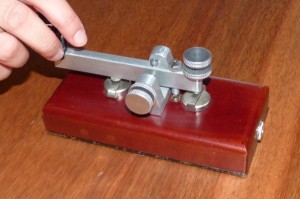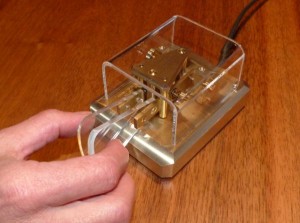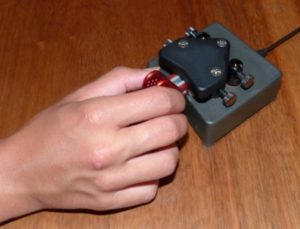Telegraphy (from the ancient Greek τῆλε tēle “far” and γράφειν gráphein “to carve, to write”, i.e. “teletype”; also Morse telegraphy or “CW” = continuous wave) is the oldest mode of operation in amateur radio. It is the wireless transmission of information by a high-frequency carrier keyed or modulated to the rhythm of Morse code. The first attempts were made more than 100 years ago. Although Morse code encodes and transmits characters “digitally”, they are usually decoded by the radio amateur himself (A1A), in contrast to the digimodes used in amateur radio (A1B).
The amateur radio bands are full of CW signals. If you understand the possibilities offered by this fascinating mode, your amateur radio life will be much richer. Learning telegraphy is easier than many believe. A few minutes of daily training will lead to exam readiness in a short time.
The preferred CW ranges on the HF amateur radio bands are as follows: 1,810-1,838, 3,500-3,580, 7,000-7,040, 10,100-10,140, 14,000-14,070, 18,068-18,095, 21,000-21,070, 24,890-24,915, and 28,000-28,070 kHz. In addition, CW transmissions are allowed on all sections of the amateur radio bands!
What does a QSO in CW sound like?
Wie hört sich ein QSO in CW an?
Why do we morse today?
Morse code is a hobby, a passion, a foreign language. Today, radio amateurs and a few commercial radio stations use Morse code.
Do we still need it?
Morse code is a mode of operation which makes it possible to establish connections all over the world with low power and small radios. If you really want to communicate with little effort, you can’t avoid Morse code. Since Morse has to be learned and not everyone knows this digital sign language, it is a kind of secret language.
What can be achieved with Morse code?
Among radio amateurs, Morse code is one of many modes of operation. It allows connections under conditions that are no longer possible with voice radio.
Radio amateurs actively participate in various competitions. One of the modes of these competitions is Morse code.
Morse code is like a foreign language. After practicing the basic skills, the speed can be increased continuously. This requires the will to achieve defined goals.
Morse learning for interested people

Learning Morse code with recording and decoding is similar to learning a language. The letters are learned one by one and recognized as a melody. All beginnings are difficult. It takes will and discipline to learn Morse code so that connections can be made on the tape. But it is fun.
Learning Morse code on your own is possible. In a Morse course, from the first lesson on, important foundations are laid for the recording of Morse signals. If you make a mistake at the beginning of learning morse code, it is very difficult to get away from this mistake.
Learning morse is preferably done in a course. A complete overview of all organizers can be found here: Amateur radio training courses
Once the basic Morse code is acquired, the LCWO program is an excellent way to further develop Morse skills.
Increase morse skills

Morse code is all about diligence, no pain, no gain! Only those who regularly decode Morse code personally or key it themselves can improve their skills. As a radio amateur, the frequencies of the FISTS Club are especially suitable. There, experienced tactile radio operators are waiting to answer general calls. They are happy to take time to exchange tips with Morse partners or to answer questions posed. www.fists.co.uk. The LCWO program is also an excellent way for advanced Morse operators to further develop their Morse skills.
The HTC (Helvetia Telegraphy Club) recommends:
Morse code is only used in amateur radio, we only need to focus on the needs of this service. Amateur radio operators must be able to answer, to react on the frequency immediately from the head.
From speed 80 BpM the HTC recommends to start with the memory training. First one uses short, only interpretable words, abbreviations, Q-codes. Later, use plain texts with extended word spacing for practice. Listen to the same text several times. The program HB9HQX Morse 7 is our tool for this! The program is suitable for beginners, returners and advanced students.
Questions: hb9afh@uska.ch
Link: Memory training (de)
Link: Learn and maintain Morse – Recipe (de)
Morse Tips

Two documents on the subject of Morse code, which are worth reading:
“DIE KUNST DER RADIOTELEGRAFIE” by N0HFF
“ZEN UND DIE KUNST DER FUNKTELEGRAFIE” by IKØYGJ
